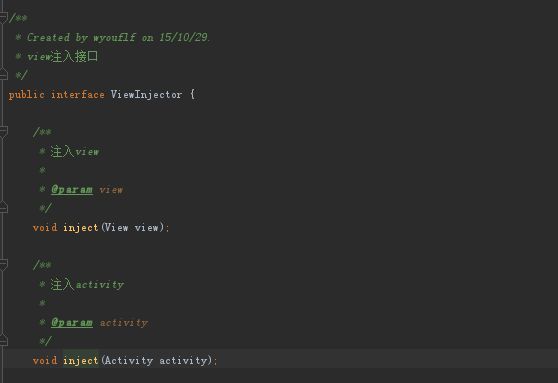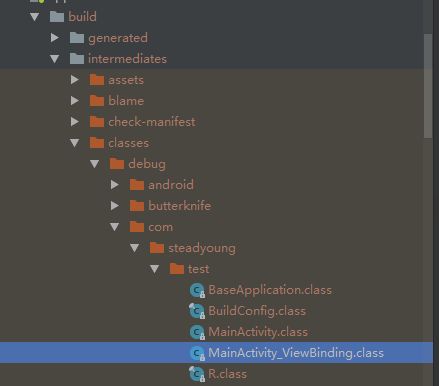1.前言
频繁的findViewById是一件挺烦人的事,IOC注解框架应运而生,Android中IOC框架就是注入控件和布局或者说是设置点击监听。
现在主流的有ButterKnife、xUtils、afinal等,IOC注解框架刚出来的时候,粗略看过源码后我是摒弃使用的,因为里面有反射、循环遍历寻找控件等操作,但是慢慢的接收了这种快捷方式,发现对实际性能影响并不大,不是在特别强迫症的情况下完全可行,特别是ButterKnife的出现,ButterKnife没有利用全反射,而是在同包下动态编译生成代码,性能几乎和自己findViewById性能是一样的!
2.源码分析
下面我们来实际分析xUtils和ButterKnife的源码:
2.1 xUtils 使用
xUtils源码地址:https://github.com/wyouflf/xUtils3
xUtils 包含了orm, http(s), image, view注解,下面我们重点讲解View注解(IOC注入):
public class MainActivity extends AppCompatActivity {
@ViewInject(R.id.test_tv)
private TextView test_tv;
@ViewInject(R.id.test_btn)
private Button test_btn;
@Override
protected void onCreate(Bundle savedInstanceState) {
super.onCreate(savedInstanceState);
setContentView(R.layout.activity_main);
x.view().inject(this);
test_tv.setText("测试文本");
test_btn.setText("测试按钮");
}
/**
* 1. 方法必须私有限定,
* 2. 方法参数形式必须和type对应的Listener接口一致.
* 3. 注解参数value支持数组: value={id1, id2, id3}
* 4. 其它参数说明见{@link org.xutils.view.annotation.Event}类的说明.
**/
@Event(value = R.id.test_btn,
type = View.OnClickListener.class/*可选参数, 默认是View.OnClickListener.class*/)
private void iconIvClick(View view) {
test_tv.setText("点击了按钮,修改测试文本");
Toast.makeText(this, "点击了按钮,修改测试文本", Toast.LENGTH_LONG).show();
}
}
注解省去了findViewById和setOnClickListener等简单操作。
2.2 xUtils源码分析
我们挑一些关键的源码分析,先分析x.view().inject(this);这句代码做了什么:
点击进入查看是一个接口ViewInjector,看不到实现代码,我就Ctrl+鼠标左键查看实现类:
找到实现类ViewInjectorImpl中inject(Activity activity)方法代码:
@Override
public void inject(Activity activity) {
//获取Activity的ContentView的注解
Class handlerType = activity.getClass();
try {
// 找到ContentView这个注解,在activity类上面获取
ContentView contentView = findContentView(handlerType);
if (contentView != null) {
int viewId = contentView.value();
if (viewId > 0) {
// 如果有注解获取layoutId的值,利用反射调用activity的setContentView方法注入视图
Method setContentViewMethod = handlerType.getMethod("setContentView", int.class);
setContentViewMethod.invoke(activity, viewId);
}
}
} catch (Throwable ex) {
LogUtil.e(ex.getMessage(), ex);
}
// 处理 findViewById和setOnclickListener的注解
injectObject(activity, handlerType, new ViewFinder(activity));
}
根据源码可知,先判断是否有ContentView这个注解,在activity类上面获取,有则setContentView(R.layout.xxxx),然后再处理 findViewById和setOnclickListener的注解(injectObject方法):
@SuppressWarnings("ConstantConditions")
private static void injectObject(Object handler, Class handlerType, ViewFinder finder) {
if (handlerType == null || IGNORED.contains(handlerType)) {
return;
}
// 从父类到子类递归
injectObject(handler, handlerType.getSuperclass(), finder);
// inject view
Field[] fields = handlerType.getDeclaredFields();
if (fields != null && fields.length > 0) {
for (Field field : fields) {
Class fieldType = field.getType();
if (
/* 不注入静态字段 */ Modifier.isStatic(field.getModifiers()) ||
/* 不注入final字段 */ Modifier.isFinal(field.getModifiers()) ||
/* 不注入基本类型字段 */ fieldType.isPrimitive() ||
/* 不注入数组类型字段 */ fieldType.isArray()) {
continue;
}
ViewInject viewInject = field.getAnnotation(ViewInject.class);
if (viewInject != null) {
try {
View view = finder.findViewById(viewInject.value(), viewInject.parentId());
if (view != null) {
field.setAccessible(true);
field.set(handler, view);
} else {
throw new RuntimeException("Invalid @ViewInject for "
+ handlerType.getSimpleName() + "." + field.getName());
}
} catch (Throwable ex) {
LogUtil.e(ex.getMessage(), ex);
}
}
}
} // end inject view
// inject event
Method[] methods = handlerType.getDeclaredMethods();
if (methods != null && methods.length > 0) {
for (Method method : methods) {
if (Modifier.isStatic(method.getModifiers())
|| !Modifier.isPrivate(method.getModifiers())) {
continue;
}
//检查当前方法是否是event注解的方法
Event event = method.getAnnotation(Event.class);
if (event != null) {
try {
// id参数
int[] values = event.value();
int[] parentIds = event.parentId();
int parentIdsLen = parentIds == null ? 0 : parentIds.length;
//循环所有id,生成ViewInfo并添加代理反射
for (int i = 0; i < values.length; i++) {
int value = values[i];
if (value > 0) {
ViewInfo info = new ViewInfo();
info.value = value;
info.parentId = parentIdsLen > i ? parentIds[i] : 0;
method.setAccessible(true);
// EventListenerManager 动态代理执行相应的方法
EventListenerManager.addEventMethod(finder, info, event, handler, method);
}
}
} catch (Throwable ex) {
LogUtil.e(ex.getMessage(), ex);
}
}
}
} // end inject event
}
源码中利用类的反射循环获取属性的注解值然后通过findViewById之后,动态的注入到控件属性里面;事件注入也是类似首先findViewById然后利用动态代理去反射执行方法,动态代理代码如下:
public static void addEventMethod(
//根据页面或view holder生成的ViewFinder
ViewFinder finder,
//根据当前注解ID生成的ViewInfo
ViewInfo info,
//注解对象
Event event,
//页面或view holder对象
Object handler,
//当前注解方法
Method method) {
try {
View view = finder.findViewByInfo(info);
if (view != null) {
// 注解中定义的接口,比如Event注解默认的接口为View.OnClickListener
Class listenerType = event.type();
// 默认为空,注解接口对应的Set方法,比如setOnClickListener方法
String listenerSetter = event.setter();
if (TextUtils.isEmpty(listenerSetter)) {
listenerSetter = "set" + listenerType.getSimpleName();
}
String methodName = event.method();
boolean addNewMethod = false;
/*
根据View的ID和当前的接口类型获取已经缓存的接口实例对象,
比如根据View.id和View.OnClickListener.class两个键获取这个View的OnClickListener对象
*/
Object listener = listenerCache.get(info, listenerType);
DynamicHandler dynamicHandler = null;
/*
如果接口实例对象不为空
获取接口对象对应的动态代理对象
如果动态代理对象的handler和当前handler相同
则为动态代理对象添加代理方法
*/
if (listener != null) {
dynamicHandler = (DynamicHandler) Proxy.getInvocationHandler(listener);
addNewMethod = handler.equals(dynamicHandler.getHandler());
if (addNewMethod) {
dynamicHandler.addMethod(methodName, method);
}
}
// 如果还没有注册此代理
if (!addNewMethod) {
dynamicHandler = new DynamicHandler(handler);
dynamicHandler.addMethod(methodName, method);
// 生成的代理对象实例,比如View.OnClickListener的实例对象
listener = Proxy.newProxyInstance(
listenerType.getClassLoader(),
new Class[]{listenerType},
dynamicHandler);
listenerCache.put(info, listenerType, listener);
}
Method setEventListenerMethod = view.getClass().getMethod(listenerSetter, listenerType);
setEventListenerMethod.invoke(view, listener);
}
} catch (Throwable ex) {
LogUtil.e(ex.getMessage(), ex);
}
}
在实例化DynamicHandler的时候穿递的是Activity/Fragment。然后调用EventListenerManager.addEventMethod(finder, info, event, handler, method);法的时候,将method(当前注解方法)传递进去了。完整类名有,方法名字有。动态代理的实现如下:
public static class DynamicHandler implements InvocationHandler {
// 存放代理对象,比如Fragment或view holder
private WeakReference2.3 ButterKnife的使用
ButterKnife源码https://github.com/JakeWharton/butterknife
相比起xutils来,ButterKnife更受欢迎,第一在性能方面xutils完全是利用的反射,butterknife是轻量级的反射使用的注解都是编译时注解,而且它还提供了一个Android Studio的插件不需要我们去写任何的代码,作者JakeWharton很出名的写过很多大型的第三方框架。
ButterKnife的代码自动生成的Android Studio插件: android-butterknife-zelezny
后期我会模仿这个插件编写一个自己的IOC注解框架的AndroidStudio插件。
public class MainActivity extends AppCompatActivity {
@BindView(R.id.test_tv)
TextView test_tv;
@BindView(R.id.test_btn)
Button test_btn;
@Override
protected void onCreate(Bundle savedInstanceState) {
super.onCreate(savedInstanceState);
setContentView(R.layout.activity_main);
ButterKnife.bind(this);
test_tv.setText("测试文本");
test_btn.setText("测试按钮");
}
@OnClick({R.id.test_tv, R.id.test_btn})
public void onViewClicked(View view) {
switch (view.getId()) {
case R.id.test_tv:
break;
case R.id.test_btn:
test_tv.setText("点击了按钮,修改测试文本");
Toast.makeText(this, "点击了按钮,修改测试文本", Toast.LENGTH_LONG).show();
break;
}
}
}
上面是ButterKnifeZelezny这个插件自动生成的代码,只需要自己实现业务逻辑代码就够了,基本 @BindView、@OnClick等注解自动生成非常好用的插件。
2.4 ButterKnife源码分析
源码入口从ButterKnife.bind(this)这里查起:
/**
* BindView annotated fields and methods in the specified {@link Activity}. The current content
* view is used as the view root.
*
* @param target Target activity for view binding.
*/
@NonNull @UiThread
public static Unbinder bind(@NonNull Activity target) {
View sourceView = target.getWindow().getDecorView();
return createBinding(target, sourceView);
}
bind(activity)最后调用了createBinding(target, sourceView),其实bind(view)和bind(dialog)等方法都会调用createBinding(target, sourceView),源码如下:
/**
* BindView annotated fields and methods in the specified {@link View}. The view and its children
* are used as the view root.
*
* @param target Target view for view binding.
*/
@NonNull @UiThread
public static Unbinder bind(@NonNull View target) {
return createBinding(target, target);
}
/**
* BindView annotated fields and methods in the specified {@link Dialog}. The current content
* view is used as the view root.
*
* @param target Target dialog for view binding.
*/
@NonNull @UiThread
public static Unbinder bind(@NonNull Dialog target) {
View sourceView = target.getWindow().getDecorView();
return createBinding(target, sourceView);
}
/**
* BindView annotated fields and methods in the specified {@code target} using the {@code source}
* {@link Activity} as the view root.
*
* @param target Target class for view binding.
* @param source Activity on which IDs will be looked up.
*/
@NonNull @UiThread
public static Unbinder bind(@NonNull Object target, @NonNull Activity source) {
View sourceView = source.getWindow().getDecorView();
return createBinding(target, sourceView);
}
/**
* BindView annotated fields and methods in the specified {@code target} using the {@code source}
* {@link View} as the view root.
*
* @param target Target class for view binding.
* @param source View root on which IDs will be looked up.
*/
@NonNull @UiThread
public static Unbinder bind(@NonNull Object target, @NonNull View source) {
return createBinding(target, source);
}
/**
* BindView annotated fields and methods in the specified {@code target} using the {@code source}
* {@link Dialog} as the view root.
*
* @param target Target class for view binding.
* @param source Dialog on which IDs will be looked up.
*/
@NonNull @UiThread
public static Unbinder bind(@NonNull Object target, @NonNull Dialog source) {
View sourceView = source.getWindow().getDecorView();
return createBinding(target, sourceView);
}
就是最终会用目标对象target和绑定的View进行处理,下面分析createBinding(target, sourceView)的源码:
private static Unbinder createBinding(@NonNull Object target, @NonNull View source) {
Class targetClass = target.getClass();
if (debug) Log.d(TAG, "Looking up binding for " + targetClass.getName());
Constructor constructor = findBindingConstructorForClass(targetClass);
if (constructor == null) {
return Unbinder.EMPTY;
}
//noinspection TryWithIdenticalCatches Resolves to API 19+ only type.
try {
return constructor.newInstance(target, source);
} catch (IllegalAccessException e) {
throw new RuntimeException("Unable to invoke " + constructor, e);
} catch (InstantiationException e) {
throw new RuntimeException("Unable to invoke " + constructor, e);
} catch (InvocationTargetException e) {
Throwable cause = e.getCause();
if (cause instanceof RuntimeException) {
throw (RuntimeException) cause;
}
if (cause instanceof Error) {
throw (Error) cause;
}
throw new RuntimeException("Unable to create binding instance.", cause);
}
}
源码中通过findBindingConstructorForClass(targetClass)获取构造方法,然后调用constructor.newInstance(target, source)通过反射调用构造方法,下面先分析findBindingConstructorForClass(targetClass):
@Nullable @CheckResult @UiThread
private static Constructor findBindingConstructorForClass(Class cls) {
//1.先从BINDINGS这个Map中获取缓存的Constructor
Constructor bindingCtor = BINDINGS.get(cls);
//2.如果有缓存那么就直接返回Constructor
if (bindingCtor != null) {
if (debug) Log.d(TAG, "HIT: Cached in binding map.");
return bindingCtor;
}
//3.反射获取目标类对象,判断是否是android和java包下的框架类,框架类终止查询构造方法操作,返回空不再进行处理
String clsName = cls.getName();
if (clsName.startsWith("android.") || clsName.startsWith("java.")) {
if (debug) Log.d(TAG, "MISS: Reached framework class. Abandoning search.");
return null;
}
try {
//4.通过反射加载(clsName + "_ViewBinding")名字的类
Class bindingClass = cls.getClassLoader().loadClass(clsName + "_ViewBinding");
//noinspection unchecked
//bindingClass 中查询参数为(cls, View.class)的构造函数,cls为最初的目标类
bindingCtor = (Constructor) bindingClass.getConstructor(cls, View.class);
if (debug) Log.d(TAG, "HIT: Loaded binding class and constructor.");
} catch (ClassNotFoundException e) {
if (debug) Log.d(TAG, "Not found. Trying superclass " + cls.getSuperclass().getName());
//报错后查询cls的父类,看是否在父类中有实现这个构造方法
bindingCtor = findBindingConstructorForClass(cls.getSuperclass());
} catch (NoSuchMethodException e) {
throw new RuntimeException("Unable to find binding constructor for " + clsName, e);
}
//将反射查询出的结果缓存在BINDINGS中
BINDINGS.put(cls, bindingCtor);
return bindingCtor;
}
根据源码分析得知(源码中我加了注释) Class bindingClass = cls.getClassLoader().loadClass(clsName + "_ViewBinding")也就是target类名+_ViewBinding,然后bindingClass.getConstructor(cls, View.class)获取这个类对应参数的构造方法,按照源码执行顺序最后要执行的也是这个方法。
我的target类是MainActivity,那么实现类是MainActivity_ViewBinding这个类,不过这个类是在编译运行时才会生成的,Ctrl+N 搜索类如下图
如果搜不到我们可以在项目目录..\app\build中找到,编译后在目录..\app\build\intermediates\classes\debug\你的包名(com\xxx\xxx)
那么下面查看MainActivity_ViewBinding的代码:
public class MainActivity_ViewBinding implements Unbinder {
private MainActivity target;
private View view2131165311;
private View view2131165310;
@UiThread
public MainActivity_ViewBinding(MainActivity target) {
this(target, target.getWindow().getDecorView());
}
@UiThread
public MainActivity_ViewBinding(final MainActivity target, View source) {
this.target = target;
View view = Utils.findRequiredView(source, 2131165311, "field 'test_tv' and method 'onViewClicked'");
target.test_tv = (TextView)Utils.castView(view, 2131165311, "field 'test_tv'", TextView.class);
this.view2131165311 = view;
view.setOnClickListener(new DebouncingOnClickListener() {
public void doClick(View p0) {
target.onViewClicked(p0);
}
});
view = Utils.findRequiredView(source, 2131165310, "field 'test_btn' and method 'onViewClicked'");
target.test_btn = (Button)Utils.castView(view, 2131165310, "field 'test_btn'", Button.class);
this.view2131165310 = view;
view.setOnClickListener(new DebouncingOnClickListener() {
public void doClick(View p0) {
target.onViewClicked(p0);
}
});
}
@CallSuper
public void unbind() {
MainActivity target = this.target;
if (target == null) {
throw new IllegalStateException("Bindings already cleared.");
} else {
this.target = null;
target.test_tv = null;
target.test_btn = null;
this.view2131165311.setOnClickListener((OnClickListener)null);
this.view2131165311 = null;
this.view2131165310.setOnClickListener((OnClickListener)null);
this.view2131165310 = null;
}
}
}
看到源码MainActivity_ViewBinding(final MainActivity target, View source)构造方法中实现了findViewById和setOnClickListener,源码中Utils.findRequiredView其实就是实现了findViewById,代码如下:
public static View findRequiredView(View source, @IdRes int id, String who) {
View view = source.findViewById(id);
if (view != null) {
return view;
}
String name = getResourceEntryName(source, id);
throw new IllegalStateException("Required view '"
+ name
+ "' with ID "
+ id
+ " for "
+ who
+ " was not found. If this view is optional add '@Nullable' (fields) or '@Optional'"
+ " (methods) annotation.");
}
那么我们注解的操作在此都实现了,所以bind(activity)等绑定的方法最后都会调用到这个构造方法来实现注解绑定UI操作!
那么MainActivity_ViewBinding这个类怎么生成的呢?
这些操作都在butterknife-compiler中,终于知道为什么ButterKnife中要添加两个框架了
dependencies {
implementation 'com.jakewharton:butterknife:8.8.1'
annotationProcessor 'com.jakewharton:butterknife-compiler:8.8.1'
}
因为butterknife-compiler编译运行时动态生成代码的过程比较复杂,我将另出一篇文章来分析:ButterKnife编译时生成代码原理:butterknife-compiler源码分析
看到MainActivity_ViewBinding的代码,我要选第三方注解框架就是ButterKnife了,插件动态生成对应class文件去直接实现注解的操作,而且Android Studio又有插件自动生成注解代码,不用自己手动写代码,非常便利!
3 总结
在源码的分析中我们扩展了只是,深入理解了反射、动态代理、编译时代码生成等,虽然直接引用第三方好用的框架可以事半功倍,但是有时间一定要去分析源码,学习大神的编码方式,学习大神的思维逻辑,并仿照编写自己的框架,后面文章我也将自己编写IOC注解框架!
自己简易打造的IOC注解框架:SteadyoungIOC



